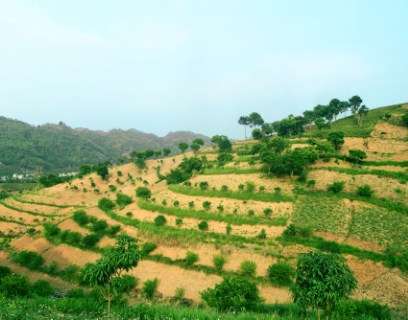
Agroforestry is a method of farming that has become increasingly important. However, in Kenyan land use is changing from extensive methods of farming to more productive and sustainable intensive methods.
What is Agroforestry?
Agroforestry is the interaction of agriculture and trees. However, this comprises of trees on the farm and in agricultural landscapes, farming in forest and along forest margins. Therefore, agroforestry is a collective name for land-use systems and technologies.
Forms of Agroforestry.
Agroforestry- is a combination of trees/ shrubs and crops in agricultural production.
Silvopastoral- is a combination of growing trees/ shrubs pastoral and keeping livestock.
Agrosilvopastoral- it is a combination of growing trees/ shrubs, animals, pasture, and crops.
Importance of Agroforestry.
- Environmental protection.
- Source of income.
- Afforestation for timber production.
- Maintenance of soil fertility.
- Aesthetic value.
- Labor-saving in firewood collection.
- Source of food and feed.
- Source of fuelwood.
Characteristics of Agroforestry tree species.
- Fast growth rate.
- Deep-rooted
- Nitrogen fixation ability.
- Be multipurpose in nature.
- Should not possess the competitive ability with the main crop.
- Have coppicing and popping ability.
- Nutritious and palatable.
Types of tree and shrubs.
Eucalyptus.
Tall trees.
- Paul Rudd age, wife, children, comedies and films, worth.
- Mark Hall Bio-Age, Edu, Children, Wife, Net Worth, Career
- Ranjita Chakravarty Age, Husband, Children, net worth.
- Toby Keith bio-age, early life, wife, children, death.
- Dillion Johnson age, family, spouse, injuries, net worth.
- Sheree Whitfield Bio, Wiki, RHOA, Age, Education, Height, Family, Husband, Children, and Career
- Eliud Owalo bio-age, wife, origin, and net worth.
Bushy trees.
Cypress.
Tree nursery.
Tree nurseries are structures used to raise the tree seedlings until they are ready for transplanting. However, there are two main types:
Bare roots nurseries- this is where the seedlings are raised directly into the soil.
Advantages.
Cheap and time-consuming
Many seedlings are raised in a small space.
Transportation of seedlings is easy.
Disadvantages.
Root damage when uprooting the seedlings.
Difficult to transport.
The lower survival rate after transplanting.
Containerized nursery- the seedlings in this type of nursery see raised in containers such as pots, polythene bags, or tubes.
Advantages.
The higher survival rate of transplanting.
No root damage.
Successful in arid areas.
Disadvantages.
Labour intensive.
Difficulty to get containers.
However, it may be difficult to get the right types of soil to use in the container.
Seed collection.
Seeds should be collected from:
- Adaptable trees.
- High yielding.
- Healthy.
- Resistant to pests.
- The mother should be identified first.
Method of seed collecting.
- Shaking the tree.
- Gathering from under the tree.
- Lopping off the tree.
- Climbing on the trees.
- Hooking method.
Seed preparation.
This is done when seeds are collected from fresh fruits. Therefore, they should be soaked in water, then washed and dried
Cleaning and sorting- this is to remove immature seeds.
Drying- is done by sun-drying or oven drying.
Nursery management.
Mulching. Aims to reduce excessive evaporation. However, it moderates the soil temperature. In addition, when it decays it improves the soil structure.
Pricking out. Is the removal of seedlings in overcrowded areas to another nursery bed. Moreover, it allows the seedlings to grow strong and healthy.
Root pruning. Is the cutting of the roots longer than the pots.
Hardening off- it is the practice of preparing seedlings to adapt to the ecological conditions prevailing in the seeded. However, it involves gradual reduction of shade and water 1-2 weeks before transplanting.
Transplanting. The practice of transferring seedlings from the nursery bed to the main field where they grow to maturity.
Agroforestry practices.
Alley cropping is the growing of multipurpose trees and shrubs together with crops. So, this improves soil fertility through nitrogen fixation and organic matter.
Multi-story cropping is growing together of trees of different heights. Therefore, they increase water conservation for pastures.
Woodlots- are plots of land set aside for trees only.
Harvesting methods.
Pollarding- is the extensive cutting back of the crown of the tree about 2-3 m above the ground level. However, it stimulates the development of a new crown and branches.
Coppicing- cutting the main stem of the tree completely at a height of 10-50cm above the ground. Therefore, the tree should be cut at a sainting angle.
Shaking of the trees- this is a method of harvesting pods and seeds from trees without cutting the trees.
Thinning- removal of some of the trees growing in lines to give the remaining trees enough space to grow.
- List of best private primary schools in Kirinyaga County.
- Bay head elementary school history, enrolment, programs offered.
- Best Public High Schools in Kiambu County.
- List of Accredited Private Universities in Kenya
- Egerton university, fees, location, courses.
- Kenya Medical Training College, courses, requirements.
- Mount Kenya University history, fees, courses